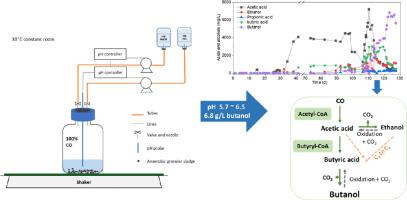Science of the Total Environment ( IF 8.2 ) Pub Date : 2021-09-25 , DOI: 10.1016/j.scitotenv.2021.150579 Yaxue He 1 , Piet N L Lens 2 , María C Veiga 3 , Christian Kennes 3

|
An anaerobic mixed culture able to grow on pure carbon monoxide (CO) as well as syngas (CO, CO2 and H2), that produced unusual high concentrations of butanol, was enriched in a bioreactor with intermittent CO gas feeding. At pH 6.2, it mainly produced acids, generally acetic and butyric acid. After adaptation, under stress conditions of CO exposure at a partial pressure of 1.8 bar and low pH (e.g., 5.7), the enrichment accumulated ethanol, but also high amounts of butanol, up to 6.8 g/L, never reported before, with a high butanol/butyric acid molar ratio of 12.6, highlighting the high level of acid to alcohol conversion. At the end of the assay, both the acetic acid and ethanol concentrations decreased, with concomitant butyric acid production, suggesting C2 to C4 acid bioconversion, though this was not a dominant bioconversion process. The reverse reaction of ethanol oxidation to acetic acid was observed in the presence of CO2 produced during CO fermentation. Interestingly, butanol oxidation with simultaneous butyric acid production occurred upon production of CO2 from CO, which has to the best of our knowledge never been reported. Although the sludge inoculum contained a few known solventogenic Clostridia, the relative taxonomic abundance of the enriched sludge was diverse in Clostridia and Bacilli classes, containing known solventogens, e.g., Clostridium ljungdhalii, Clostridium ragsdalei and Clostridium coskatii, confirming their efficient enrichment. The relative abundance of unassigned Clostridium species amounted to 27% with presumably novel ethanol/butanol producers.
中文翻译:

通过富集厌氧培养从一氧化碳中选择性生产丁醇
厌氧混合培养物能够在纯一氧化碳 (CO) 以及合成气(CO、CO 2和 H 2)上生长,产生异常高浓度的丁醇,并在间歇式 CO 气体进料的生物反应器中进行富集。在 pH 6.2 时,它主要产生酸,一般是乙酸和丁酸。适应后,在分压为 1.8 bar 和低 pH(例如 5.7)的 CO 暴露压力条件下,富集积累了乙醇,但也积累了大量的丁醇,高达 6.8 g/L,以前从未报道过,具有12.6 的高丁醇/丁酸摩尔比,突出了酸到醇的高转化率。在测定结束时,乙酸和乙醇的浓度均降低,同时产生丁酸,表明 C 2C 4酸生物转化,尽管这不是主要的生物转化过程。在 CO 发酵过程中产生的 CO 2存在下观察到乙醇氧化成乙酸的逆反应。有趣的是,丁醇氧化与丁酸同时生产发生在从 CO生产 CO 2时,据我们所知从未报道过这种情况。虽然污泥接种物含有一些已知产溶剂梭菌,富集的污泥的相对丰度的分类是多样的梭菌属和芽孢杆菌类,含有已知solventogens,例如,梭菌属ljungdhalii,拉氏梭菌和Clostridium coskatii,证实了它们的有效富集。未分配的梭菌物种的相对丰度达到 27%,可能是新型乙醇/丁醇生产商。

































 京公网安备 11010802027423号
京公网安备 11010802027423号